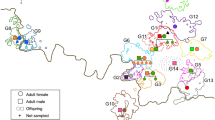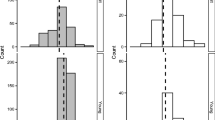Abstract
Red brocket deer Mazama americana includes at least two lineages that differ at the level of karyotypes and phylogenetic relationships based on mtDNA. Also, hybrids between them have been proved to be nonviable or infertile. Since successful breeding is hampered, we expect selection to have produced a precopulatory barrier between these lineages based on courtship behaviour, to prevent investment in unsuccessful breeding. Here we made experiments with specimens in captivity to investigate mating preferences for partners belonging to the same or different karyotypes or lineages, along with a white-tailed deer buck (Odocoileous virginianus) as an outgroup control. Behaviours were video recorded and analysed by using Generalized Linear Mixed Models, with the interacting females and males as random subjects. The results show that although red brocket females never accepted copulations with the control male, trials involving pairs of red brocket deer may or may not end with copulation regardless as to whether the partners belonged to the same or different lineages. Although some male and female behaviours differed when pairs belonged to the same or different lineages, our results do not support the existence of a precopulatory barrier between lineages in the red brocket deer complex. We discuss the implications for sympatric speciation and species conservation.
Similar content being viewed by others
References
Abril, V.V., Carnelossi, E.A.G., Gonzales, S., Duarte, J.M.B., 2010. Elucidating the evolution of the red brocket deer Mazama americana complex (Artiodactyla; Cervidae). Cytogenet. Genome Res. 128, 177–187.
Allen, J.A., 1915. Notes on American deer of the genus Mazama. Bull. Am. Mus. Nat. Hist. 34, 521–553.
Amato, G., Egan, M.G., Schaller, G.B., 2000. Mitochondrial DNA variation in Muntjac: evidence for discovery, rediscovery, and phylogenetic relationships. In: Schaller, G.B., Vrba, E.S. (Eds.), Antelopes, Deer, and Relatives: Fossil Record, Behavioural Ecology, Systematics, and Conservation. Yale University Press.
Andersson, M.A., 1994. Sexual Selection. Princeton University Press, Princeton, NJ, USA.
Aquino, C.I., Abril, V.V., Duarte, J.M.D., 2013. Meiotic pairing of B chromosomes, multiple sexual system, and Robertsonian in the red brocket deer Mazama Americana (Mammalia, Cervidae). Genet. Mol. Res. 12, 3566–3574.
Baker, R.J., Bickham, J.W., 1986. Speciation by monobrachial centric fusions. Proc. Natl. Acad. Sci. U. S. A. 83, 8245–8248.
Barry, K.L., Kokko, H., 2010. Male mate choice: why sequential choice makes its evolution difficult. Anim. Behav. 80, 163–169.
Biedrzycka, A., Solarz, W., Okarma, H., 2012. Hybridization between native and introduced species of deer in Eastern Europe. J. Mammal. 93, 1331–1341.
Bodmer, R.E., 1997. Ecologia e conservação dos veados mateiro e catingueiro na Amazônia. In: Duarte, J.M.D. (Ed.), Biologia e Conservação de Cervídeos Sul-Americanos: Blastocerus, Ozotozeros e Mazama. Fundação de Estudos e Pesquisas em Agronomia. Medicina Veterinária e Zootecnia Jaboticabal, São Paulo Brazil.
Bradbury, J.V., Vehrencamp, S.L., 2011. Principles of Animal Communication. Sinauer Associates, Sunderland MA.
Brennan, P.A., 2010. Pheromones and mammalian behavior. In: Menini, A. (Ed.), The Neurobiology of Olfaction. CRC Press/Taylor & Francis, Boca Raton, Florida.
Britton-Davidian, J., Catalan, J., Ramalhinho, M.G., Ganem, G., Auffray, J.-C., Capela, R., Biscoito, M., Searle, J.B., Mathias, M.L., 2000. Rapid chromosomal evolution in island mice. Nature 403, 158.
Cabrera, A., 1960. Catálogo de los mamíferos de América del Sur. Revista Museo Argentino Bernardino Rivadavia 4, 309–732.
Carranza, J., Roldán, M., Carvalho-Peroni, E.F., Duarte, J.M.B., 2017. Weak premating isolation between two parapatric brocket deer species. Mamm. Biol. 87, 17–26, http://dx.doi.org/10.1016/j.mambio.2017.02.009.
Coyne, J.A., Orr, H.A., 2004. Speciation. Sinauer Associates U.S.A, Sunderland, MA.
Curlewis, J.D., Loudon, A.S.I., Coleman, A.P.M., 1988. Oestrous cycles and the breeding season of the Père David’s deer hind (Elaphurus davidianus). J. Reprod. Fertil. 82, 119–126.
Cursino, M.S., Salviano, M.B., Abril, V.V., Zanetti, E.S., Duarte, J.M.B., 2014. The role of chromosome variation in the speciation of the red brocket deer complex: the study of reproductive isolation in females. BMC Evol. Biol. 14, 40.
Czernay, S., 1987. Spiesshirsche und Pudus. Die Neue Brehm-Bücherei 581, 1–84.
Dawkins, R., 1982. The Extended Phenotype: The Long Reach of the Gene. Oxford University Press, Oxford, UK.
Dobzhansky, T., 1937. Genetics and the Origin of Species. Columbia University Press, New York.
Dougherty, L.R., Shuker, D.M., 2015. The effect of experimental design on the measurement of matechoice: a metaanalysis. Behav. Ecol. 26, 311–319.
Duarte, J.M.B., Jorge, W., 2003. Morphologic and cytogenetic description of the small red brocket (Mazama bororo Duarte, 1996) in Brazil. Mammalia 67, 403–410.
Duarte, J.M.B., Merino, M.L., 1997. Taxonomia e evolução. In: Duarte, J.M.B. (Ed.), Biologia e Conservacao de Cervideos Sulamericanos: Blastocerus, Ozotoceros e Mazama. FUNEP, Jaboticabal, Brazil, pp. 1–21.
Duarte, J.M.B., González, S., Maldonado, J.E., 2008. The surprising evolutionary history of South American deer. Mol. Phylogenet. Evol. 49, 17–22.
Duarte, J.M.B., 1996. Guia de Identificação de Cervídeos Brasileiros. Jaboticabal, Brazil, FUNEP.
Dunn, J.C., Halenar, L.B., Davies, T.G., Cristobal-Azkarate, J., Reby, D., Sykes, D., Dengg, S., Fitch, W.T., Knapp, L.A., 2015. Evolutionary tradeoff between vocal tract and testes dimensions in howler monkeys. Curr. Biol. 25, 1–6.
Eberhard, W.G., 1996. Female Control: Sexual Selection by Cryptic Female Choice. Princeton Univ. Press, Princeton, NJ.
Eisemberg, J.F., 1989. Mammals of the Neotropics, vol. I. University of Chicago Press, Chicago (pp 449).
Emmons, L.H., 1990. Neotropical Rainforest Mammals, a Field Guide. University of Chicago Press, Chicago (pp 281).
Escobedo-Morales, L., Mandujano, S., Eguiarte, L.E., Rodríguez-Rodríguez, M.A., Maldonado, J.E., 2016. First phylogenetic analysis of Mesoamerican brocket deer Mazama pandora and Mazama temama (Cetartiodactyla: cervidae) based on mitochondrial sequences: implications on Neotropical deer evolution. Mamm. Biol. 81, 303–313.
Ferrandiz-Rovira, M., Lemaître, J.F., Lardy, S., López, B.C., Cohas, A., 2014. Do pre- and postcopulatory sexually selected traits covary in large herbivores? BMC Evol. Biol. 14, 79.
Futuyma, D.J., 2005. Evolution. Sinauer & Associates, Inc., Massachusetts.
Gadella, B.M., 2010. Interaction of sperm with the zona pellucida during fertilization. Soc. Reprod. Fertil. Suppl. 67, 267–287.
Geist, V., 1998. Deer of the World: Their Evolution, Behaviour, and Ecology. Stackpole Books, Mechanicsburg.
Heckeberg, N.S., Erpenbeck, D., Wörheide, G., Rössner, G.E., 2016. Systematic relationships of flve newly sequenced cervid species. PeerJ 4, http://dx.doi.org/10.7717/peerj.2307 (e2307).
Howard, D.J., Gregory, P.G., Chu, J.M., Cain, M.L., 1998. Conspecific sperm precedence is an effective barrier to hybridization between closely related species. Evolution 52, 511–516.
Howard, D.J., Palumbi, S.R., Birge, L.M., Manier, M.K., 2009. Sperm and speciation. In: Birkhead, T.R., Hosken, D.J., Pitnick, S. (Eds.), Sperm Biology: An Evolutionary Perspective. Elsevier, Oxford, pp. 367–403.
Huang, L., Wang, J., Nie, W., Su, W., Yang, F., 2006. Tandem chromosome fusions in karyotypic evolution of Muntiacus: evidence from M feae and M. gongshanensis. Chromosome Res. 14, 637–647.
Irwin, D.E., Irwin, J.H., Price, T.D., 2001. Ring species as bridges between microevolution and speciation. Genetica 112-113, 223–243.
Johnstone, R.A., 1997. The evolution of animal signals. In: Krebs, J.R., Davies, N.B. (Eds.), Behavioural Ecology: An Evolutionary Approach., 4th ed. Blackwell Scientific, Oxford, pp. 155–178.
Kokko, H., Brooks, R., Jennions, M.D., Morley, J., 2003. The evolution of mate choice and mating biases. Proc. Biol. Sci. 270, 653–666.
Lacy, R.C., Sherman, W., 1983. Kin recognition by phenotype matching. Am. Nat. 121, 489–512.
Ludt, C.J., Schroeder, W., Rottmann, O., Kuehn, R., 2004. Mitochondrial DNA phylogeography of red deer (Cervus elaphus). Mol. Phylogenet. Evol. 31, 1064–1083.
Mayr, E., 1963. Animal Species and Evolution. Harvard University Press, Cambridge.
Morales-Piñeyrua, J.T., Ungerfeld, R., 2012. Pampas deer (Ozotoceros bezoarticus) courtship and mating behavior. Acta Vet. Scand. 54, 60–66.
Parker, G.A., Birkhead, T., 2013. Polyandry: the history of a revolution. Philos. Trans. R. Soc. Lond. B 368, 20120335.
Parker, G.A., 1970. Sperm competition and its evolutionary consequences in insects. Biol. Rev. Camb. Philos. Soc. 45, 525–567.
Pfennig, K.S., 1998. The evolution of mate choice and the potential for conflict between species and matequality recognition. Philos. Trans. R. Soc. Lond. Bio. 265, 1743–1748.
Piálek, J., Albrecht, T., 2005. Choosing mates: complementary versus compatible genes. Trends Ecol. Evol. 20 (2), 63.
Price, E.O., 2008. Principles and Applications of Domestic Animal Behavior An Introductory Text. CABI, Cambrige University Press, Cambridge, UK.
Ptacek, M.B., 1998. Interspecific mate choice in sailfin and shortfin mollies. Anim. Behav. 56, 1145–1154.
Ptacek, M.B., 2000. The role of mating preferences in shaping interspecific divergence in mating signals in vertebrates. Behav. Process. 51, 111–134.
Putman, R.J., Hunt, E.J., 1993. Hybridization between red and sika deer in Britain. Deer 9, 104–110.
Rossi, R.V., 2000. Taxonomia de Mazama Ranfinesque, 1817 do Brasil (Artyodactyla, Cervidae). Universidade de São Paulo, São Paulo, Brazil (Msc, Thesis).
Ryan, M.J., Tailor, R.C., 2015. Measures of mate choice: a comment on Dougherty and Shuker. Behav. Ecol. 26, 323–324.
Salviano, M.B., Cursino, M.S., Zanetti, E.D.S., Abril, V.V., Duarte, J.M.B., 2017. Intraspecific chromosome polymorphisms can lead to reproductive isolation and speciation: an example in red brocket deer (Mazama americana). Biol. Reprod. 96 (6), 1279–1287, http://dx.doi.org/10.1093/biolre/iox041.
Samsudewa, D., Capitan, S.S., 2011. Reproductive behaviour of Timor deer (Rusa timorensis). Wartazoa 21, 108–113.
Senn, H.V., Pemberton, J.M., 2009. Variable extent of hybridization between invasive sika (Cervus nippon) and native red deer (C. elaphus) in a small geographical area. Mol. Ecol. 18, 862–876.
Servedio, M.R., Noor, M.A.F., 2003. The role of reinforcement in speciation: theory and data. Annu. Rev. Ecol. Syst. 34, 339–364.
Shackleton, M.A., Jennions, M.D., Hunt, J., 2005. Fighting success and attractiveness as predictors of male mating success in the black fleld cricket, Teleogryllus commodus: the effectiveness of nochoice tests. Behav. Ecol. Sociobiol. 58, 1–8.
Shah, K.B., Tripathy, S., Suganthi, H., Rudraiah, M., 2014. Profiling of luteal transcriptome during prostaglandin F2-alpha treatment in buffalo cows: analysis of signaling pathways associated with luteolysis. PLoS One 9 (8), e104127.
Todesco, M., Pascual, M.A., Owens, G.L., et al., 2016. Hybridization and extinction. Evol. Appl. 9, 892–908.
Tomkins, T., Bryant, M.J., 1974. Oestrous behaviour of the ewe and the influence of treatment with progestagen. J. Reprod. Fertil. 41, 121–132.
Trivers, R.L., 1972. Parental investment and sexual selection. In: Campbell, B. (Ed.), Sexual Selection and the Descent of Man, 1871-1971. Aldine-Atherton, Chicago, IL, pp. 136–179.
Varela, D.M., Trovati, R.G., Guzmán, K.R., Rossi, R.V., Duarte, J.M.B., 2010. Red brocket deer-Mazama americana. In: Duarte, J.M.B., González, S. (Eds.), Neotropical Cervidoloy: Biology and Medicine of Latin American Deer. FUNEP/IUCN, Jaboticabal, pp. 151–159.
Veen, T., Faulks, J., Rodríguez-Muñoz, R., Tregenza, T., 2011. Premating reproductive barriers between hybridising cricket species differing in their degree of polyandry. PLoS One 6, 1–7.
Wagner, C.E., Harmon, L.J., Seehausen, O., 2012. Ecological opportunity and sexual selection together predict adaptive radiation. Nature 487, 366–369.
Zanetti, E.S., Duarte, J.M.B., Polegato, B.F., Garcia, J.M., Canola, J.C., 2010. Assisted reproductive technology. In: Duarte, J.M.B., Gonzáles, S. (Eds.), Neotropical Cervidology. FUNEP, Jaboticabal, pp. 255–270.
van Doorn, G., Edelaar, P., Weissing, F.J., 2009. On the origin of species by natural and sexual selection. Science 326, 1704–1707.
Author information
Authors and Affiliations
Corresponding author
Rights and permissions
About this article
Cite this article
Carranza, J., Roldán, M. & Duarte, J.M.B. Lack of mate selectivity for genetic compatibility within the red brocket deer Mazama americana complex. Mamm Biol 88, 168–175 (2018). https://doi.org/10.1016/j.mambio.2017.09.006
Received:
Accepted:
Published:
Issue Date:
DOI: https://doi.org/10.1016/j.mambio.2017.09.006




